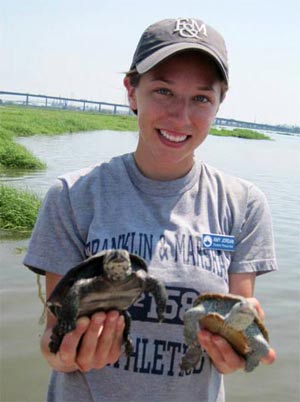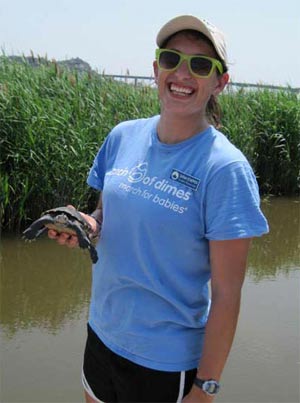|
Population Study of Snapping Turtles in an
Estuarine Creek in Cape May County, New Jersey

Thom Donahue, St. John’s College
This study has gathered valuable information on the life processes of snapping turtles, including population size and distribution. We captured and measured 25 individual snapping turtles, including hatchlings and juveniles, from various sections of Stone Harbor’s Crooked Creek. Dietary analysis has pointed strongly toward herbivory in larger specimens, at least within the creek's freshwater reaches. It is hypothesized that snapping turtles, nominally a freshwater species, are possibly utilizing the seaward sections of the creek to supplement a dearth of food opportunities. Turtles in freshwater have been known to host leeches, while those in water with even a low salinity do not. The removal of these parasites may serve as a further incentive for an estuarine life. An important research tool has been the use of microchips for the establishment of a database that should prove to be an invaluable foundation for future study.
Egg Sizes and Hatching Success Rates in Relation
to the Size and Age of Adult Female Diamondback Terrapins

Maureen Duffy, Richard Stockton College of New Jersey
Eggs were harvested from female diamondback terrapin roadkills that were collected during road patrols. Several measurements from the female and of each egg were taken to gain insight into egg sizes and hatching success rates in relation to the size and age of the female. I used growth rings and the size of the females to establish a correlation with the average size of the eggs and the hatching success rate. There is no significant correlation between age and the size of the eggs or the size of the female. The size of the female has a positive correlation with the size of the eggs.
Day vs. Night Roadkills and Hatching Success

Lisa Griffith, Kutztown University
The diamondback terrapin (Malaclemys terrapin terrapin) is the only turtle species that has adapted to live solely in the brackish water of a salt marsh environment. They have become a species of Special Concern due to habitat destruction along the coast of New Jersey. As a consequence of dwindling natural nesting habitat, female terrapins have resorted to nesting along road sides, which has resulted in numerous terrapin roadkills. Since 1989, the Wetlands Institute has been committed to decreasing the number of roadkills each year. In an effort to save diamondback terrapins, daily road patrols have been conducted during day and night hours throughout the entire nesting season (late May to mid-July). Eggs are collected from road-killed females and brought back to our lab to be incubated at a controlled temperature. Roadkill data were analyzed to establish whether more terrapins were killed during the day or the night, as well as whether more potentially viable eggs were recovered during the day or the night. I examined roadkill data for nine different nesting seasons spanning sixteen years. I also looked at the hatching success from rescued eggs over the past few years. The data showed an equal number of daytime and nighttime roadkills, with more potentially viable eggs recovered during the daytime and greater hatching success from eggs recovered from the daytime roadkills.
Food Habits of Nesting Bald Eagles (Haliaeetus leucocephalus) in New Jersey

Matthew Jargowsky, University of Maine
In New Jersey conservation efforts made during the past three decades have helped bald eagle (Haliaeetus leucocephalus) populations to increase, from just one nesting pair in 1982 to 94 nests in 2010. However, little is known about their diets, so to better understand their dietary preferences I examined the skeletal remains recovered from eagle nests throughout New Jersey. From the 50 different nest samples I received, the only reptiles found in eagle nests were turtles, most of which were juveniles. The most common reptiles found were diamondback terrapins (Malaclemys terrapin terrapin) (100) and musk turtles (Sternotherus odoratus) (38). The most common mammals found were muskrats (Ondatra zibethicus) (67), with the other mammals being identified as rabbit (Sylvilagus floridanus) (5), deer (Odocoileus virginianus) (3), woodchuck (marmota monax) (2), beaver (Castor canadensis) (1), and opossum (Didelphis virginiana) (1). Overall, the mammals in the nests were of smaller size, with the larger species such as deer being juveniles. The most common fish in the eagles’ nests were catfish, especially brown and channel, most likely the by-catch of fishermen, making them easy for eagles to scavenge. Although birds were not as common as the other types of animals, the birds found were often of large size such as waterfowl, gulls, or herons.
 |


Amy Jordan
|


Sarah Scheffer
|
|
Kinis, Birds, & Binos: A Behavioral Study of Piping Plover Chicks in Relation to Fledging Success

Amy Jordan and Sarah Scheffer
Piping plovers (Charadrius melodus) breed and nest on New Jersey barrier beach islands from April to September. Declines in chick fledging success due to habitat loss, human disturbance, and predation have resulted in the listing of piping plovers as federally Threatened, and Endangered in the State of New Jersey. During this study piping plover chicks from two locations in New Jersey (Avalon and Stone Harbor Point) were observed, based on a predetermined set of 11 behaviors to determine the relationship between the duration of time spent foraging for food and fledging success. Six broods were observed over a three-week period using two-minute bouts over an hour to quantify foraging time versus ten other behaviors. The two nesting sites were also compared to determine if there were other habitat controls that affected the success of the chicks between the two sites.
Preliminary results reveal that fledging success is higher at Stone Harbor Point than at Avalon due to the morphology and uses of each site. Stone Harbor Point is a natural beach with limited human activity and hosts more varied foraging prospects, whereas Avalon is used primarily for recreational activities and offers little foraging variety. In this experimental study, greater time spent foraging and fledging success appears to correlate positively.

The Effectiveness of Terrapin (Malaclemys terrapin terrapin) Barrier Fences along Roadways in Coastal Southern New Jersey

Hannah Reses, University of Michigan
Every year from late May through early July, female diamondback terrapins (Malaclemys terrapin terrapin) emerge from the salt marshes of southern New Jersey to lay their eggs. Coastal development has stripped the terrapins of their original nesting habitat, so the turtles are forced to lay their eggs on road shoulders, which leads to hundreds of roadkills annually. To combat roadkills, Wetlands Institute researchers and volunteers have installed various types of barrier fencing. My project analyzed the effectiveness of the terrapin barrier fences along the roadways of coastal of southern New Jersey. I studied 15 years of roadkill data (pre- and post- barrier fence installation), and I monitored barrier fences on Stone Harbor Boulevard and the Margate Causeway for evidence of predated nests. Resultant data reveal that terrapins are nesting more frequently on the marsh side of the fences and that more roadkills occurred in the pre-fence years, so it can be concluded that the fences are effective. Also, this study indicates that corrugated tubing is the most promising type of fence tested thus far, but it remains to be seen how well it will hold up over time. It is important to establish the effectiveness of these fences to know that our conservation efforts are being properly allocated.
Comparison of Scute Anomalies between Headstarters
and Natural Populations of Northern Diamondback terrapin (Malaclemys terrapin terrapin)

Jen Savaro, Coastal Carolina University
The northern diamondback terrapin (Malaclemys terrapin terrapin), like all hard-shelled turtles, has a protective shell composed of hard, bone plates covered by keratin scutes. Phenotypic anomalies in regard to the number and shape of scutes on a terrapin's shell are common. This study compared the differences in scute anomalies between diamondback terrapin headstarters and wild populations of terrapins in the Cape May Peninsula of New Jersey. The purposes of the study were to determine whether a particular anomaly might be correlated with headstarter hatchling death and to see if egg incubation has an effect on the amount of anomalies present in hatchlings. Anomalies present on artificially incubated hatchlings were examined and then compared with mark-release-recapture data from the wild population. Anomalies present on deceased hatchlings were then compared with live hatchlings, and the frequency of anomaly occurrence was calculated. It was found that the most common anomalies are split cervical, vertebral, and costal scutes. No clear correlation was found between death of hatchlings and the percentage of scute anomalies. Headstarters tend to have a higher frequency of fourth and fifth vertebral and costal anomalies than the natural population. Incubated hatchlings had a higher percentage of scute anomalies than do the adult natural population, which suggests that the environment of artificial incubation is conducive to development of scute anomalies. This could be due to the constant temperature and drier, warmer conditions than natural nests where temperature and humidity fluctuate daily and throughout the nesting period.
Variation in Scute Anomalies among Three Diamondback Terrapin Populations

Stephanie Wolfe, Stony Brook University
Diamondback terrapin (Malaclemys terrapin terrapin) is a species of special interest in the state of New Jersey. Little is known about terrapin shell anomalies (irregularities of the scales that make up a turtle’s shell). My project analyzed scute anomalies in diamondback terrapin populations located on the Cape May Peninsula, the Hackensack Meadowlands, and the Florida Keys. Previous research indicated that warmer incubation temperatures will produce more anomalies. Since diamondback terrapins have temperature-dependent sex determination, and warmer temperatures are required to produce females, it is predicted that more females will have anomalies than males. The pattern and frequency of each type of anomaly at each of the three populations was also analyzed. It was found that females tend to have more anomalies than males, supporting the hypothesis that warmer incubation temperatures may lead to higher frequencies of anomalies. In all populations, carapace (top shell) anomalies were found to be more common than plastral (bottom shell) anomalies. In the Cape May Peninsula terrapin population, 31% were anomalous. In the Hackensack Meadowlands, 62% of the terrapin population were anomalous. In the Florida Keys mangrove terrapin population, 60% were anomalous. Both New Jersey populations exhibit the same types of anomalies, but the Hackensack Meadowlands has a significantly higher frequency of anomalies than the Cape May Peninsula. Key West has a distinct pattern of anomalies that is different from what was found in the New Jersey populations. These results indicate that one or any combination of biological, environmental, or anthropogenic factors may account for anomaly differences between sexes and between populations.
Factors Influencing Body Temperature and Incubation
Success of Eggs from Road Kill Diamondback Terrapin (Malaclemys terrapin)

Natalie Young, Rowan University
Road patrol efforts have resulted in the collection of thousands of diamondback terrapin eggs. Studying the hatching success and internal body temperatures of roadkills may help conservationists understand critical temperature ranges for terrapin eggs. In this study, internal body temperatures of roadkills were recorded during road patrols. A side study was also conducted to further understand the internal body temperature of roadkills. Twenty four roadkills were placed on asphalt, and their internal body temperatures were measured every five minutes from 8 p.m. to 6 p.m. (22 hours total). The 24 turtles were placed on the asphalt using different start times, beginning with eight turtles at 8 p.m., eight more at 6.a.m., and the last eight at 12 p.m. The data indicate that body temperatures of roadkills vary based on the time of day the turtle was collected. Night time and early morning body temperatures are significantly different from late morning and afternoon body temperatures. Body temperatures at 2 p.m. are significantly higher. Also, body temperature is not significantly influenced by size or degree of damage to the roadkill. Research on hatching success rates is currently ongoing.
|